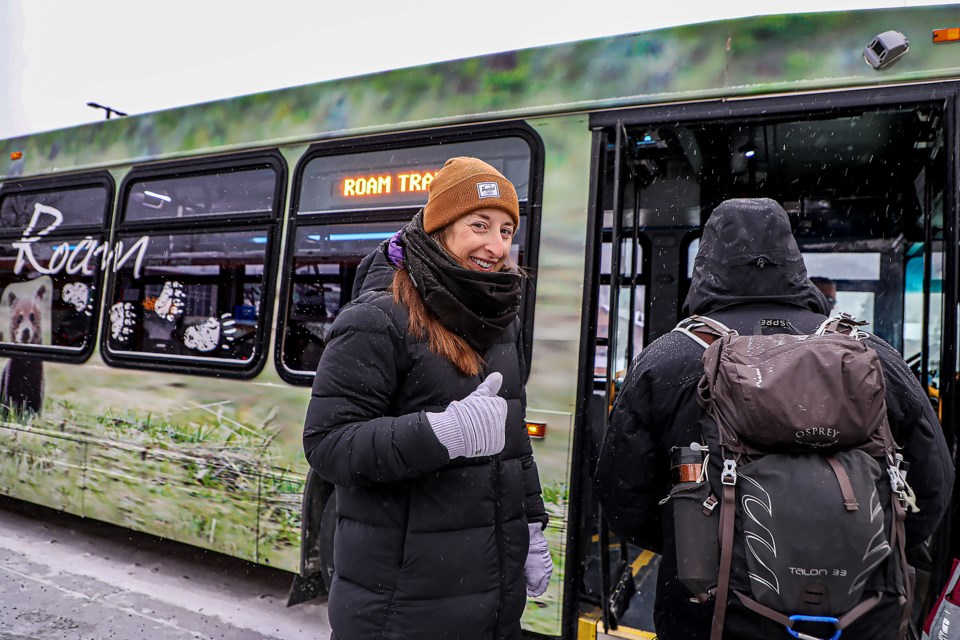BANFF – Following a summer that had dramatic reduction in operation staff, Roam transit will be discussing how staff housing could potentially fill the gap.
The Bow Valley Regional Transit Services Commission (BVRTSC) will receive more information from staff after they were presented with the option of buying or leasing space in a new development in Teepee Town in Canmore.
While no decision has been made, Roam signed a lease for a three-bedroom property in Middle Springs in Banff that will begin Jan. 1, 2023.
“It’ll help us be able to give at least some transitional housing where people can come out and have somewhere either for a whole summer or a few months until they are able to secure somewhere in the valley,” said Martin Bean, CEO of Roam transit. “It gives us the option to bring in staff, primarily drivers from other locations such as Calgary and Edmonton and give them a chance to get settled in the valley.”
Last summer, the main issue in recruiting and retaining was lack of housing. It led to a shortage of about seven drivers, causing Roam to rely on existing drivers to collect overtime to maintain the frequency of routes. Some routes were also scaled back to accommodate the driver shortage.
A staff report highlighted that the growth of Roam has meant a greater need for staffing, particularly operationally with mechanics and drivers. However, rather than it being a year-round issue, the growth is largely in the busy summer months when routes expand and tourist visitation increases in the valley.
“It’s easier to hire people for full-time year-round positions than it is for seasonal,” Bean said. “We’ve had the opportunity to bring in more drivers from Calgary and they weren’t able to easily find accommodation and chose not to come because of that reason. We’re hoping this will give the ability to bring in some of those potentially more experienced drivers.”
Bean said the transit authority has already moved forward in hiring staff and will begin mandatory entry level training in January that will continue throughout the summer. He added they’ve had success in finding applicants, who are able to train on the service’s driver simulator located in the Roam administration building in Banff.
Bean noted they’re continuing to look at the potential of another two- or three-bedroom place in either Banff or Canmore to avoid the driver shortage felt last summer.
One possibilty is to purchase a unit or lease at Bald Eagle Peak Chalets in Canmore. Bald Eagle Peak Chalets was approved by the Canmore Planning Commission in 2021, but a lengthy Subdivision and Development Appeal Board process led to a delayed start to construction. It’s expected to be finished in late 2023 or early 2024.
The development will have 13 townhome units and six employee housing units.
The purchase price for a five-bedroom, five-bathroom unit would have been about $1.2 million, according to a staff report. The rental option for the same choice was estimated at about $5,000 a month.
The 2023 budget – which has been approved by the commission and approved by Canmore council but not yet by Banff council – sets aside $20,500 for housing options for drivers.
ONE MILLION RIDERS IN BANFF
Roam transit hit a major milestone when it surpassed one million riders on Banff local routes in 2022.
The number was reached Tuesday (Dec. 20) morning on route 2 and is a further sign transit is becoming the main option for residents and visitors to get to destinations.
Along with Banff Mayor Corrie DiManno and Bean, Roam transit marked the occasion at the downtown transit hub near Banff Community High School.
“It’s really exciting for us to hit that number,” Bean said. “It’s a number above what we were able to accomplish in 2019. With the increased service that we’ve put on Banff local routes in winter months, we’ve seen ridership staff up quite a bit higher than it has in the past, even in the off-season.”
According to Roam, ridership through the end of November is slightly more than 1.5 million compared to roughly 1.44 million in 2019 for a 4.8 per cent increase.
Banff is served by three local routes 1, 2 and 4, while route 3 is the regional bus between Canmore and Banff and 8x goes between Lake Louise and Banff. The No. 9 also leaves Banff to Johnston Canyon and runs on weekends in the winter.
Banff’s governance and finance committee recommended council approve the purchase of new electric buses to help increase the frequency of Route 1 – which goes to the Banff hot springs and Sulphur Mountain gondola – from 20 minutes to 15 minutes. The buses are expected to be brought into service in 2025, once approved by council.
“Transit is a lot more convenient for people when it’s running every 20 to 25 minutes than in previous winters when it was 40 to 45 minutes between buses,” Bean said.
RIDERSHIP FROM JAN. 1, 2022 TO NOVEMBER 30, 2022
- Route 1: 504,988 (510,674 in 2019)
- Route 2: 420,009 (396,088 in 2019)
- Route 3: 174,524 (182,010 in 2019)
- Route 5: 159,200 (129,889 in 2019)
- Route 8x: 123,669 (108,804 in 2019)
- Route 9: 21,977 (10,993 in 2019)




